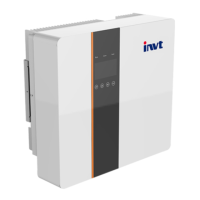
Do you have a question about the INVT BD Series and is the answer not in the manual?
| Cooling Method | Forced air cooling |
|---|---|
| Output Voltage | 0~Input Voltage |
| Control Mode | V/F |
| Control Method | V/F control |
| Overload Capacity | 150% rated current 60s; 180% rated current 10s |
| Braking | Built-in braking unit (Optional) |
| Communication | Modbus |
| Communication Interface | RS485 |
| Protection Features | Overvoltage, Undervoltage, Overcurrent, Overload, Overtemperature, Short circuit, Phase loss |
| Ambient Temperature | -10°C~+40°C |
| Storage Temperature | -20°C~+60°C |
| Humidity | 0~95% (non-condensing) |
| Altitude | Less than 1000m, derating is required if exceeding 1000m |
Covers manual scope, target audience, and explanation of safety symbols.
Covers electrical, burn, and radiation hazards associated with inverter operation.
Details surge protection devices, PE connection, leakage current, and grounding requirements.
Provides essential safety measures for handling high-voltage batteries during maintenance.
Explains inverter symbols and outlines compliance with European CE directives.
Introduces the inverter's capabilities and illustrates system diagrams for different versions.
Details various operating modes including self-use, time-based, backup, and EPS functions.
Details DC input parameters like max power, voltage limits, and MPPT ranges.
Provides AC output and input specifications including power, voltage, current, and power factor.
Covers internal charger capabilities and inverter efficiency ratings.
Details EPS output specifications and general inverter data.
Guides on inspecting the inverter for damage and verifying package contents.
Provides precautions for mounting and outlines the general steps for installation.
Specifies the minimum clearance distances required around the inverter for installation.
Provides a step-by-step guide for securely mounting the inverter on the wall.
Guides on connecting PV modules, including series configurations and voltage limitations.
Details the steps and recommendations for connecting the inverter to the grid.
Explains the differences between 'I' and 'E' versions for EPS functionality.
Guides on EPS wiring and outlines requirements for EPS load connections.
Covers battery breaker installation, power connection, and BMS PIN definition.
Illustrates meter connection and defines PIN assignments for communication.
Provides instructions for connecting the inverter to a DRM system for demand response.
Guides on setting up WiFi connection for data monitoring.
Guides on setting up GPRS connection for remote load control.
Details pre-start checks and the procedure for starting up the inverter.
Describes the control panel, LED indicators, and instructions for setting work modes.
Guides on configuring PV input modes and battery parameters for optimal performance.
Details peak load shifting setup and selection of various operational work modes.
Explains the LCD interface, PV/battery displays, and BMS parameter readings.
Displays real-time grid-connected and inverter output voltage, current, and frequency.
Shows load status, power readings, and temperature information from the inverter.
Covers status information, error codes, and system setting summaries.
Guides on accessing user settings, inputting passwords, and navigating menus.
Overview of various system settings including work mode, EPS, and grid standards.
Detailed settings for work modes, EPS enable, and battery wake-up configurations.
Covers remote control, start delay, and PV input mode settings.
Interface for selecting the battery type, such as Lead-acid or various Li-ion types.
Specific parameter settings for Custom-Li batteries, including voltage and OVP.
Parameters for Lead-acid batteries: charge voltage, end voltage, OVP, and capacity.
Configuration for battery charge voltage, end voltage, OVP, and capacity.
Settings for reactive mode, power factor, and reactive power adjustments.
Configuration for reactive power and grid-connected power percentage.
Settings for grid over/under voltage and over/under frequency protection points.
Settings for grid-connected power and discharge power percentages.
Configuration for 485 address, baud rate, and language selection.
Settings for LCD backlight brightness and system date/time.
Option to clear historical data from the inverter's record.
Interface for changing the password to access setup features.
Displays inverter model, serial number, and firmware versions.
Shows running records, including fault codes and timestamps.
Covers maintenance procedures and options for factory resetting the inverter.
Accesses various inquiry functions such as module info, SN, firmware, and records.
Displays inverter operation time and grid-connection frequency statistics.
Shows daily and monthly energy production and consumption statistics.
Displays yearly and total gross energy production and consumption statistics.
Provides a table listing common faults, their codes, and suggested solutions.
Troubleshooting steps for battery over-voltage and under-voltage errors.
Solutions for faults related to grid voltage, frequency, and abnormal conditions.
Troubleshooting for PV connection issues, GFCI faults, and grounding problems.
Solutions for charging over-current faults and related issues.
Troubleshooting for faults related to bus, inverter, relay, and communication issues.
Solutions for PV short circuits and incorrect battery connections.
